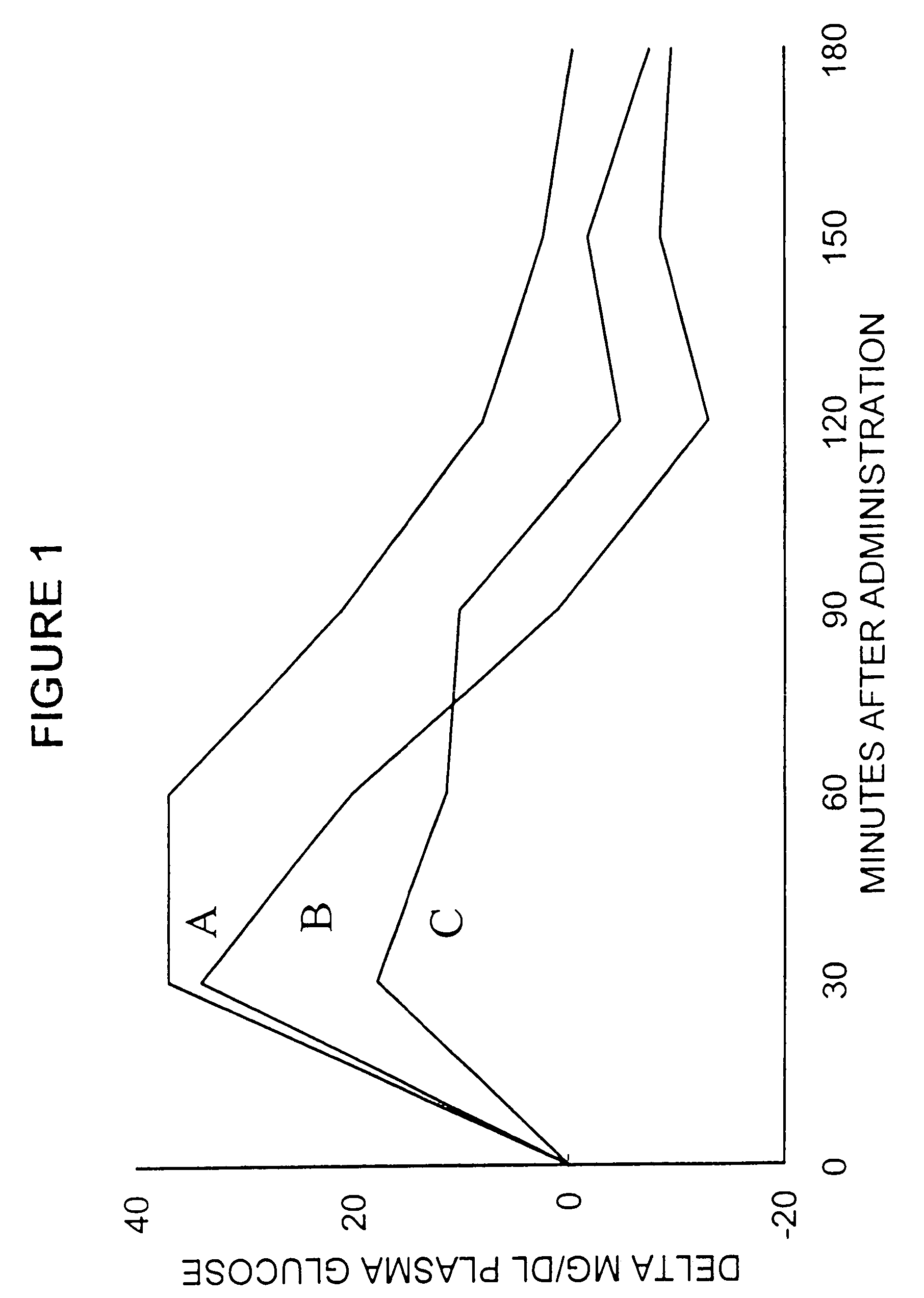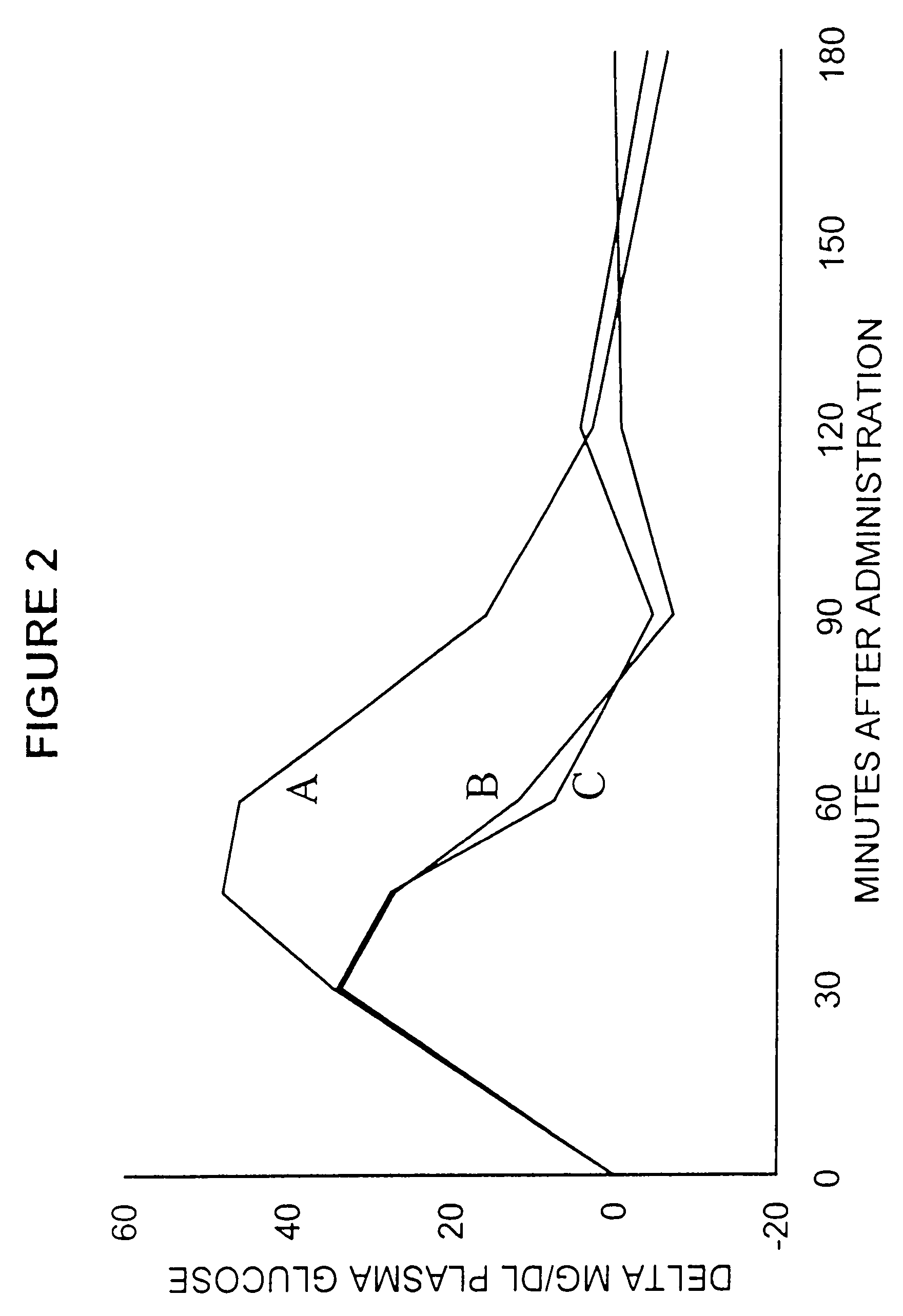Mixtures of fructose, sucrose and lactose as a low-calorie bulk sweetener with reduced glycemic index
a technology of glycemic index and sugar, applied in the field of sugar mixtures, can solve the problems of not always consistent with human, obesity epidemic in the us, rats and pigs, the only two animals reported, and the effect is admittedly counter-intuitive, so as to reduce caloric value, reduce glycemic index, and reduce the effect of caloric valu
- Summary
- Abstract
- Description
- Claims
- Application Information
AI Technical Summary
Benefits of technology
Problems solved by technology
Method used
Image
Examples
example 1
Interactions of Lactose, Sucrose, Fructose and α-Dextrins (Maltose) in the Small Intestine
[0060]The test subject (Subject #1) was a 54-year-old Caucasian male in good health, with a body mass index (BMI) equal to 28.6 kg / m2. The subject was required to exercise moderately at least 30 minutes each day before testing, sleep at least 7 hours the previous night, and fast for no less than 12 hours prior to oral tolerance testing (OTT) early the next morning. Water was restricted 1.5 hours prior to testing, and only small sips of water were allowed infrequently during OTT. The test article, described below, was ingested as quickly as possible after the time 0 blood sample was obtained. Subsequent blood samples were taken at 30, 60, 90, 120, 150, and 180 minutes, and plasma glucose measurements were recorded in units of mg / dL immediately each time using a hand-held glucometer (At•Last model, Amira Medical, Scotts Valley, Calif. 95066). The subject abstained from food and remained sedentary...
example 2
Caloric Values of Mixtures of Lactose, Sucrose, and Fructose
[0079]Test articles were aqueous solutions (in 200 g water) of 50 g of total carbohydrates, which were prepared early in the morning before the test. All of the same protocol criteria were applied for the test, as described in Example 1 above, except that times for blood samples were 0, 30, 45, 60, 90, 120, and 180 minutes. The test subjects were Subject #1, described above, and Subject #2, a 24-year-old, healthy Caucasian male (BMI=27.7 kg / m2). See FIGS. 3 and 2, respectively, for results of their OTT's.
[0080]Calculation of estimated caloric value (ECV) demands some explanation here, as the calculation requires acceptance of some reasonable assumptions:[0081]GI values for lactose monohydrate, fructose, sucrose and oat starch are 46, 23, 64, and 100, respectively.[0082]Caloric values for lactose monohydrate, fructose, sucrose and oat starch are 3.8, 3.7, 3.9, and 3.7 kcal / g, respectively.[0083]The order for complete active ...
example 3
Use of New Sweetener by Impaired Glucose Tolerant Subject
[0094]The test subject with impaired glucose tolerance (IGT) was an 84-year-old Caucasian male (BMI=21.5 kg / m2) in relatively good health. His daily drug regimen included Coumadin® and Cardoxin®, all taken after OTT. The same OTT protocol for Example 1 was used for the IGT subject. See FIG. 4 for IGT's OTT results.
[0095]IGT showed a peak plasma glucose increase at 30 minutes for the 20 g lactose / 14 g sucrose / 16 g starch test article (curve B) that was 39% of the peak from 34 g sucrose / 16 g starch (curve A). His plasma glucose concentration remained nearly constant for ˜1.5 hours after peaking, then dropped back to nearly baseline by 3 hours. The subject felt no GI effects. Unlike the sucrose / starch control (curve A), the lactose / sucrose / starch test article(curve B) never caused his plasma glucose level to break above 200 mg / dL, an important criterion for diabetes (especially at 2 hours). The AUC for the sucrose / lactose / starch ...
PUM
| Property | Measurement | Unit |
|---|---|---|
| body weight | aaaaa | aaaaa |
| body weight | aaaaa | aaaaa |
| weight | aaaaa | aaaaa |
Abstract
Description
Claims
Application Information
 Login to View More
Login to View More - R&D
- Intellectual Property
- Life Sciences
- Materials
- Tech Scout
- Unparalleled Data Quality
- Higher Quality Content
- 60% Fewer Hallucinations
Browse by: Latest US Patents, China's latest patents, Technical Efficacy Thesaurus, Application Domain, Technology Topic, Popular Technical Reports.
© 2025 PatSnap. All rights reserved.Legal|Privacy policy|Modern Slavery Act Transparency Statement|Sitemap|About US| Contact US: help@patsnap.com



